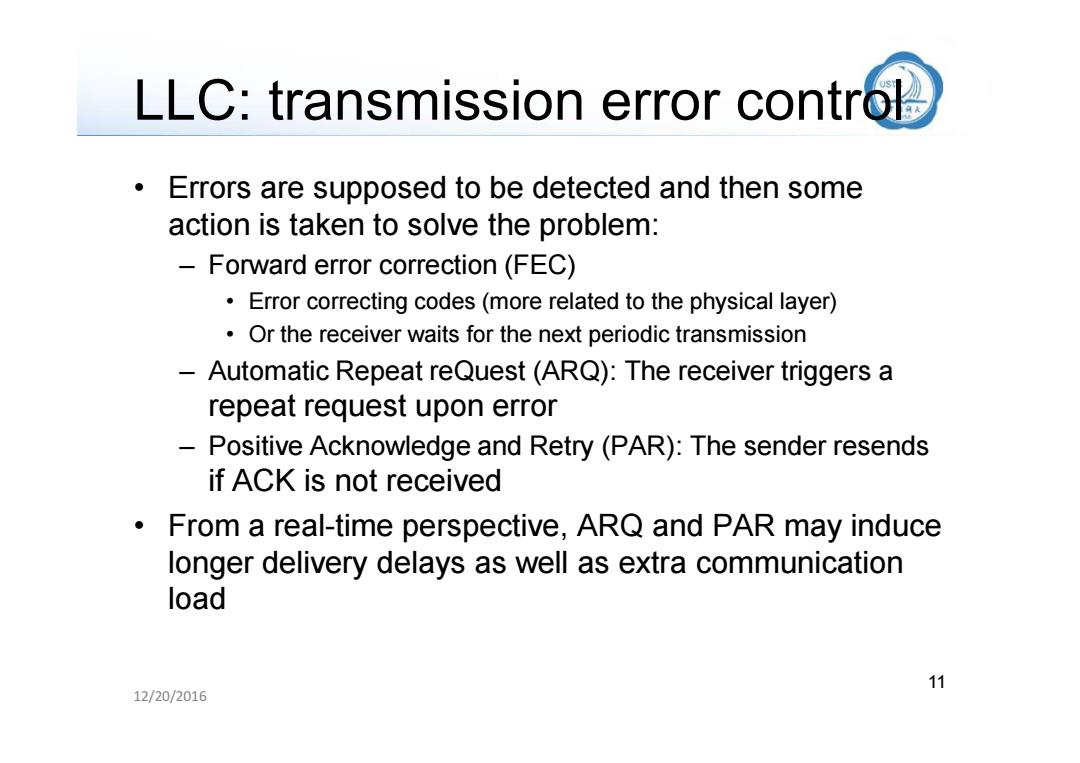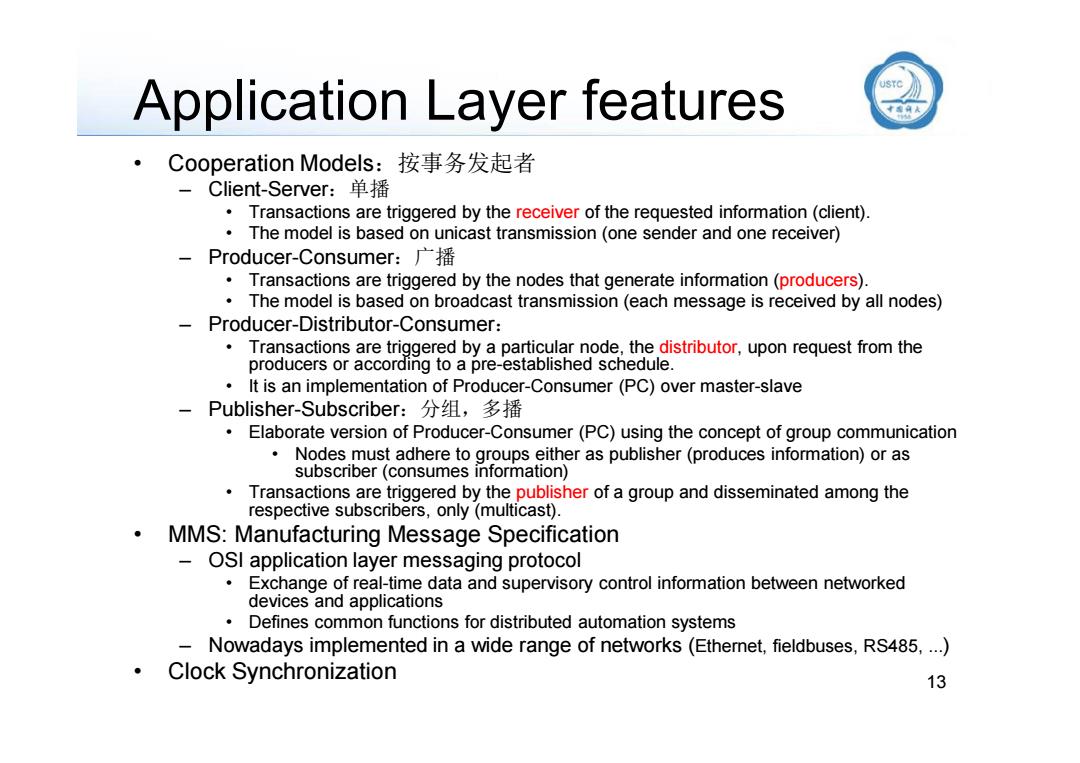
LLC:transmission error control 。 Errors are supposed to be detected and then some action is taken to solve the problem: Forward error correction (FEC) Error correcting codes(more related to the physical layer) Or the receiver waits for the next periodic transmission -Automatic Repeat reQuest(ARQ):The receiver triggers a repeat request upon error Positive Acknowledge and Retry(PAR):The sender resends if ACK is not received From a real-time perspective,ARQ and PAR may induce longer delivery delays as well as extra communication load 11 12/20/2016
11 12/20/2016 LLC: transmission error control • Errors are supposed to be detected and then some action is taken to solve the problem: – Forward error correction (FEC) • Error correcting codes (more related to the physical layer) • Or the receiver waits for the next periodic transmission – Automatic Repeat reQuest (ARQ): The receiver triggers a repeat request upon error – Positive Acknowledge and Retry (PAR): The sender resends if ACK is not received • From a real-time perspective, ARQ and PAR may induce longer delivery delays as well as extra communication load

Medium Access Control (MAC) 0 Decides who is to get access to the shared medium. Master-slave:WorldFIP,Ethernet Powerlink Master messages are natural synchronization points supports precise tx triggering TDMA:TTP/C,FlexRay-sync,TT-CAN,PROFINET Tight synchronization with bus time(Time-slots are predefined) Requires global (clock)synchronization CSMA:asynchronous bus access ·CSMA/CD 。 CSMA/BA:Deterministic,Ex:CAN CSMA/CA:sensing during mini-slots Collision-free and deterministic Examples:FlexRay-async(Byteflight),ARINC629-async Therefore determines the network access delay 12 12/20/2016
12 12/20/2016 Medium Access Control (MAC) • Decides who is to get access to the shared medium. – Master-slave: WorldFIP, Ethernet Powerlink • Master messages are natural synchronization points supports precise tx triggering – TDMA: TTP/C, FlexRay-sync, TT-CAN, PROFINET • Tight synchronization with bus time (Time-slots are predefined) • Requires global (clock) synchronization – CSMA: asynchronous bus access • CSMA/CD • CSMA/BA: Deterministic, Ex: CAN • CSMA/CA: sensing during mini-slots – Collision-free and deterministic – Examples: FlexRay-async (Byteflight), ARINC629-async • Therefore determines the network access delay

Application Layer features ·Cooperation Models:按事务发起者 -Client--Server:单播 Transactions are triggered by the receiver of the requested information(client). The model is based on unicast transmission(one sender and one receiver) -Producer-Consumer::广播 Transactions are triggered by the nodes that generate information(producers). The model is based on broadcast transmission(each message is received by all nodes) Producer-Distributor-Consumer: Transactions are triggered by a particular node,the distributor,upon request from the producers or according to a pre-established schedule. It is an implementation of Producer-Consumer(PC)over master-slave -Publisher-Subscriber:分组,多播 Elaborate version of Producer-Consumer(PC)using the concept of group communication Nodes must adhere to groups either as publisher(produces information)or as subscriber (consumes information) Transactions are triggered by the publisher of a group and disseminated among the respective subscribers,only (multicast). 。 MMS:Manufacturing Message Specification OSI application layer messaging protocol Exchange of real-time data and supervisory control information between networked devices and applications Defines common functions for distributed automation systems Nowadays implemented in a wide range of networks(Ethernet,fieldbuses,RS485,...) Clock Synchronization 13
13 Application Layer features • Cooperation Models:按事务发起者 – Client-Server:单播 • Transactions are triggered by the receiver of the requested information (client). • The model is based on unicast transmission (one sender and one receiver) – Producer-Consumer:广播 • Transactions are triggered by the nodes that generate information (producers). • The model is based on broadcast transmission (each message is received by all nodes) – Producer-Distributor-Consumer: • Transactions are triggered by a particular node, the distributor, upon request from the producers or according to a pre-established schedule. • It is an implementation of Producer-Consumer (PC) over master-slave – Publisher-Subscriber:分组,多播 • Elaborate version of Producer-Consumer (PC) using the concept of group communication • Nodes must adhere to groups either as publisher (produces information) or as subscriber (consumes information) • Transactions are triggered by the publisher of a group and disseminated among the respective subscribers, only (multicast). • MMS: Manufacturing Message Specification – OSI application layer messaging protocol • Exchange of real-time data and supervisory control information between networked devices and applications • Defines common functions for distributed automation systems – Nowadays implemented in a wide range of networks (Ethernet, fieldbuses, RS485, ...) • Clock Synchronization